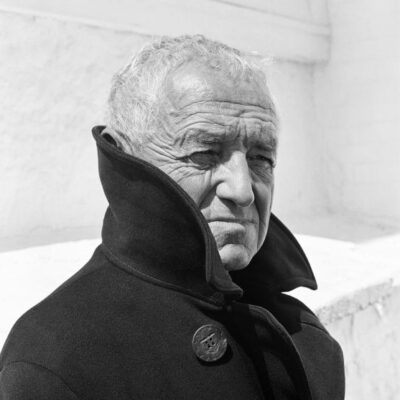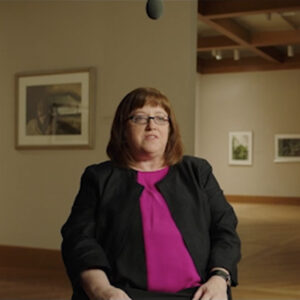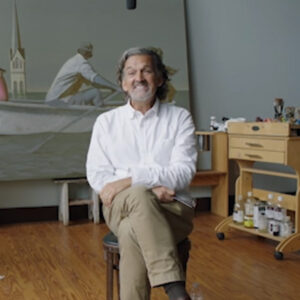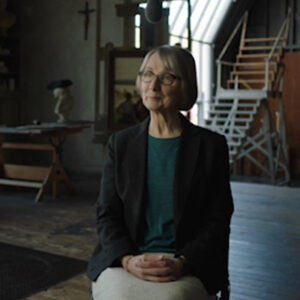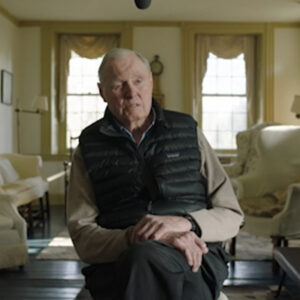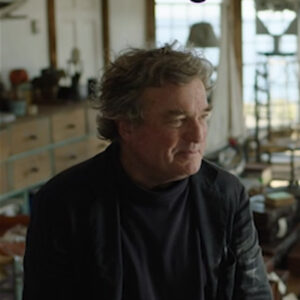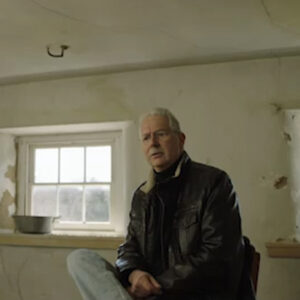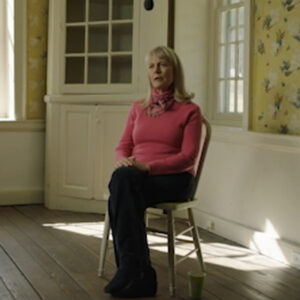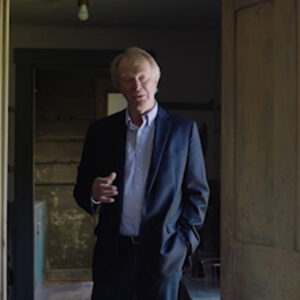Speaker Hi, I’m Wanda Corn and a teacher and a scholar and a museum curator, and I would love to try a little bit of your history with Mr. Wyatt and maybe just talk about the first time you sort of embraced life’s work on that show that other day.
Speaker I was very young and very fortunate to be offered the opportunity to curate an exhibition of Andy Wyeth’s work in San Francisco. The Dzung Museum had just joined with the Army. Kellock, the De Young Museum, had just joined and become a partner with the California Palace of the Legion of Honor. And the director of the two museums wanted to cement the partnership with a really major exhibition. And he had gone to the wife’s and asked their permission to mount an exhibition on the West Coast, which would have been the first for a really major retrospective, a kind of midlife retrospective. So in 1973, that exhibition happened at the Deong Museum. Prior to that, I had a year and a half to make that exhibition work and to write a book about him, or at least edit a book with my own contribution as one of the major essays.
Speaker So 1973, where does that fall in sort of Andrew Wyeth ascendants at the top of that review has that phase of his life?
Speaker Yes, in the 1970s, he was already becoming a figure that was provocative. In the early 1970s. His work was really, I should say, let me just think of what do you want to go back or do we want to start with the early 70s? I can stay with this. Yeah, let’s let’s go back. And then maybe we can track it a little bit and I can say then get back to the 70s. You know, when Andrew Wyeth’s work was first scene, which was very early in his life, he had a watercolor show in 1937 when he was all of 20 years old.
Speaker That is said to have sold out in a couple of days. These were beautiful watercolors, much inspired by Winslow Homer. That’s what the critics said. And I think that’s fair enough as a major influence on on Andrew Wyeth, because Winslow Homer was also a major influence on NCUA of his father. And probably NC introduced Andy Wyeth to the work of Winslow Homer. In any case, for the first 10 years or so of his exhibiting life, all of which happened in New York City, even though he continued to live in Chadds Ford, he had very high success in selling, but also critical success in the estimates that you would read about newspapers and magazines. So in the late 30s, all the way through the 40s, he was an artist to keep your eye on. His big moment, I suppose, was when the Museum of Modern Art decided to buy a painting by him that was in 49. They bought the most recent painting, which had been on view in a gallery exhibition. Of course, that was Christina’s world, which is in the Museum of Modern Art today. I just happened to see it yesterday, the beginning in the 1950s. There did beginning in the 1950s, there was kind of a shift in critical reception of Wyeth’s work. There were always those that appreciated what he did and how he did it. And we’re very excited by him. Technically, his use of Tempora, his scenery, the kinds of figures that he was doing. But beginning in the early 50s, you begin to get a critical voice that finds that he is too much tied to figuration, the word that we used at the time, rather than going in the more modern direction, or so they would say, of abstract art. So in the 50s, you begin a kind of cleavage in the criticism. Those that sort of take the standard line, that he’s kind of a brilliant artist, very young in life, and others that are beginning to say that he’s leaning too much towards realism. He wasn’t alone in receiving that criticism. We have to only think about other realists at work at that time. Edward Hopper always comes to mind, but there was also Jacques Levine. Philip, ever good? There was a number of artists that are very much appreciated today who were continuing to work while the New York School of Abstract Art was in its ascendancy. But there comes a moment, mostly in the 60s and 70s, where abstract art becomes the definition of what contemporary art is. And in that climate, Andrew began to look old fashioned that you. That word was used, in fact, that he was not of this age some wonderful quote, I think of the time and I and I abstract artist said I like Andrew Wyeth’s work, but I also like pre Rafeal light work and he’s just not a man of our century. That was the gist of some of the of the criticism that he worked in a mold that could be linked to the 19th century, but no longer to the 20th. So critically and a lot of this criticism is coming out of New York critics who are heralding as the American School of the Moment what we call the New York school or the abstract expressionist school. And they are becoming the artists of to watch at that particular time.
Speaker Could you give me some examples of these artists to watch? Who are the names being?
Speaker Well, it’s the era of Jackson Pollock, of de Kooning, of Roethke, Mark Rothko. These were the artists that Clement Greenberg, for instance, one of the major critics at the time, was celebrating and creating a vocabulary for by calling them things like abstract expressionist. We could always say that Andrew Wyeth is also an expressionist, but we wouldn’t precede that by the word abstract and following in Greenberg’s wake, so to speak, there were other younger critics that were picking up his way of determining the excellence of the age and deciding that it lay in abstract art and not in figuration.
Speaker So why was this particular criticism? Critics, why were they so influential? How were they? They were influencing the whole world, right?
Speaker Yes. Well, I think that if we look at the history of criticism, art, criticism, if we look at the history of contemporary art criticism, it’s probably useful to reflect on the fact that this is all after World War Two, where there had been such horrible carnage and destruction.
Speaker And the one of the defenses for abstract art was that it was an international language. It wasn’t a national language. It spoke to it spoke to everyone because it was not an art of very specific regional material or of figural scenes that would be more appealing maybe to a local audience as opposed to a national and international one. So one of the things that Clement Greenberg did is to give birth to this whole idea that American art had come of age, that up until that time we did not have a school of painting that would be emulated by those artists working abroad and that this was a language that surpassed nationalism. And if you remember, the nationalism that drove World War to nationalism was getting a bad name at that particular time. And this is more what we let me just think about. Oh, nationalism. What it was, was a was a word that was used a great deal in the 30s and 40s. And Clem Clement Greenberg and other critics wanted to avoid using language that tied their school of abstract expressionism to the specifics of of New York or at that particular time. It was also the period of the Cold War and during the Cold War where we have enmity with the Soviet Union. The notion that I think where I was thinking this was like, OK, so this was the period also of the Cold War when American ideologies were at war with those coming out of the Soviet Union. And one of the things that abstract expressionist could be used to support was freedom of expression. Freedom of expression is something Americans take great pride that they honor and have as a kind of basic part of their democracy and their democratic democratic ideals. They could put that against the Soviet Union, where there were mandates as to what art ought to look like and in fact, had to look like to have any success. And there was a Soviet Union, if you will, kind of vocabulary of heroism and the the the folk at work that abstract expressionist could be put into opposition. So, in fact, abstract art was even used by federal government, our federal government, to be to send in exhibitions abroad to show how liberal American artists were, but also to show them that the vocabulary that they used was not one tied to state ideology, was not one like the Soviet Union was projecting and. The Soviet Union, you also had had similar kinds of of nationalist programs in fascist Italy and in, of course, Nazi Germany.
Speaker How interesting. I’ve never heard it in that context. That’s exciting.
Speaker Yeah, there’s a whole book on it, is there, that I’m quoting.
Speaker But let me just get a drink of water.
Speaker So is this the beginning of the white curtains? Can you talk to me about that phrase? You know, what do you think that encompasses?
Speaker Well, I I’ve been a Wyeth watcher ever since 1971, 72, when I met him for the first time. And then I did this exhibition in San Francisco in 73. And while I was very much aware at the time that his work was.
Speaker I want to keep repeating this, but anyway, I was very much aware at the time that there was a lot of rather dogmatic criticism that was growing up around his work. And I was determined to be more even handed in my writing about him and also to appreciate the way in which he comes out of kind of 1930s art speak or art think in this country when regionalist art was very much in its heyday and also in the traditions of his father. But in the longer tradition of American landscape, he was a very important figure, it seemed to me, to both honor but also to watch. But the longer I stayed as a watcher of Andrew Wyeth, the more I realized that there was really a kind of vendetta against the fact that his work was so successful that he was having continual invitations to show his work in galleries and museums in particular. He never had to hurt. He never hurt for selling a work. There was always a group of people that had signed a wait list for a new Andrew Wyeth Tempora. He didn’t produce that much work in any given year because of his very arduous and labor intensive techniques. So I came up with this word for the critical dispute, if we can put it that way, or the disputatious ness of the criticism at the time.
Speaker And I decided I would call it the Wyeth curse. The wiseacres seemed to me a good term because, A, it was irrational in many ways. It was people judging him without looking at him and also people judging his audience as if somehow he the audience that went to Andrew Wyeth would not be the audience that would then turn around and go see an exhibition by Jackson Pollock or Willem de Kooning. And those seemed to me in the 70s to be kind of fallacious grounds on which to make a critical judgment. So I began to follow what I called the curse. And I have now written an essay that looks at the the content of the curse. But I’ve also been a Kliper. I clip all the news reports. I can I know that the museum does here as well. But I have been watching the degree to which this criticism has waxed and waned over the over the years at its peak, the way that.
Speaker Oh, oh, my goodness. And en route to fix it, just fix it, just let me get that nice constructive feedback I could make you keep it on this tough talk for a little bit and somebody will eventually let me know what I can come back in. All right. Very good. Let me just. All right. Thank you, sir.
Speaker If we could go into a little bit more detail about. Yeah. In terms of the super helpful. Yeah. And you don’t need to think about it. OK, stop and stop. I just love the fact you’re editing. It’s a lot of pressure off me, I gather, and that’s what I do for a living in the gathering. Yeah. Okay. Okay. I don’t know where we go.
Speaker We’re going to go the content into the death of the wife.
Speaker Yeah.
Speaker And looking back over the criticism of of why it’s work and and reading, particularly critics, that we’re finding something wrong or difficult about Wyeth, I began to realize that there was a certain kind of litany, if you will, to the criticism. One was that he was his father’s son. He was more illustrative than he was in the fine arts tradition. Another thing was that he he was a member of a generation that had become obstructionists. And, of course, he was a realist or a figurative artist rather than an abstract one. And thirdly, there was a sense that his he was easy, that the reason he gathered these mass audiences for his exhibition was because he was accessible. They could the audience members of that audience could understand his art and be moved by it without having to work very hard. There was also in that notion of shallowness, this sense that Wyeth was played to his audience, that he wasn’t subtle enough or nuanced enough to put him into a category of the art of, let’s say, Edward Hopper, who is managed to somehow not have the curse following him the same way that Andrew Wyeth has. So there is this sort of sense that he and there’s also a legacy. There’s another sense of some of the curse that he doesn’t change his art, which I would vehemently disagree with. His art has had very different phases and different models and different ways in which his own age as an artist has affected what he has painted. So the there has been more change in his art than the criticism has allowed for that. They kind of impose, if you will, a kind of sameness across his work, as if he doesn’t grow or change as an artist and held that against him as an artist of Stacie’s, if we could put it that way, as opposed to mobility and growth.
Speaker And the fact that, again, as you mentioned, that he was financially successful, he was selling things that seemed to create resentment.
Speaker Yes, I think that’s I think it’s quite another thing about the curse that’s very interesting is that while that may have been the view of the readers of very what we might call the high art of criticism, the fact is that he had a huge audience. He had many collectors or many people who wanted at least one Andrew Wyeth in their home. And he’s never hurt for audiences. There’s there’s never been a moment when audiences don’t flock to see whatever he’s putting on view or is in a museum exhibition. And he was criticized for that. It was like it was used against him as if success meant that he was a less that success meant that he was less a lesser artist than other artists. That would have to work harder for audiences. And one of the things I have thought a great deal about is the degree to which there is a there’s a darkness to Andrew Wyeth’s work. There’s a drama to it. There is tension and odd points of entry into his painting so that if you look closely at it, you can see there’s a complexity to the way he puts a painting together that was not fairly treated by the critics because they had kind of pigeonholed him and typecast him into this particular kind of old fashioned realist artist so that he didn’t even get what he deserved was which what would have been a kind of criticism that based itself on having watched him over the years and seen him develop as an artist of some maturity and greatness.
Speaker That’s a good point. Some people aren’t. And sort of paying attention because they just put them in one category, so other would be more carefully watched and have debate and discussion about it. But I think way, which is kind of like putting to you and you have to talk about this, we do not talk about it directly with one another.
Speaker However, let me just say that what one of the things that I really felt was wonderful about Andrew Wyeth was that this criticism didn’t become something that he would bring up easily or very often. It kind of rolled off his shoulders. I think his wife, Betsy Wyeth, probably was more bothered by it than Andrew Wyeth was. Andrew was very confident in his technique. He was very confident that he was an artist, like his father was an artist that he had. Creativity was an important element to him. He found that when asked about abstract painting, he’d say, that’s fine, we should all kinds of painting should exist at the same time. And I think even once he said something like, what I don’t like is dogma about art, when you only should be painting in a certain way as opposed to what he was always honoring, which is painting comes from within him as an artist and not something that he’s told by the outside world he ought to be doing. He was very generous with the critics. He did not make it an everyday conversation. And I think in a way he could bury that. It would help him to bury his sentiments about the critics so that it didn’t affect him in the studio.
Speaker I’m wondering if there is some modern elements in his work. Yeah, he said I have more I have more in common with friends. Kind of, you might think.
Speaker Yes. Yes. He did say that about Franz Kline. I think there are several ways in which he did. He would describe his work in order that it be seen more in harmony with abstract art. For instance, he would say over and over again that he’d like to turn his paintings upside down and judge the composition by what he saw. And if it didn’t have the strength of composition upside down, when, of course, it would look more abstract that work, then it wasn’t it wasn’t yet a good painting as far as he was concerned. He also talked a lot about this as he also talked not so much to me, but he would say to other critics about the spatter of paint as particularly watercolors, that he was a very messy watercolor painter and he saw that what some of the things he was doing. I’m sure he was thinking of Jackson Pollock somewhere in the back of his mind, had that kind of freedom and texture and wildness that he also knew was honored within the abstract expressionist credo.
Speaker I just got no idea what you were talking, I think, when you put some paintings upside down in my film. Oh, yeah?
Speaker Well, do you do something like, I don’t know, Brown Swiss would be good or, um, what’s the one with the trough of water in it? Turn that one upside down. Brown Swiss is really good and kerner’s farm with the little White House is very good.
Speaker Do one where there’s a lot of a lot of empty spaces. Springford Yeah. Yeah I forgot you know.
Speaker Well he does this. Can I ask you, are you comfortable talking about the fact that was embraced by MoMA and then perhaps not so embraced by me.
Speaker Makes me so mad. But I’ll try. I’ll do it.
Speaker I’m actually wrestling with how to deal with that in the film. I’m not quite sure at the moment. But any ideas you have?
Speaker Well, somebody has written a book, you know, about it that is on the MoMA staff. I have not read the book. Have you read it, Christine? Just a little book. And it’s clearly it’s clearly for they want to sell.
Speaker They know they’re taking it is holding up the painting.
Speaker I think it’s a whole book on the painting that one of the characters would like a four or five page. Yeah, it’s not at all.
Speaker It doesn’t I don’t think it does any new research or new point of view, but it’s to capture that audience that comes saying, where is Christina’s world and sell a book.
Speaker So can you talk about the you didn’t mention earlier on the fact that he was his star was rising. He was brought to the attention.
Speaker Yeah. Yeah.
Speaker Andrew Wyeth was in an important 1940s exhibition at the Museum of Modern Art called American Realist and Magic Realist. And that was really the big moment when he was seen. With a number of other New York artists and his style, which had sort of and his style had ways, the exhibition American Realism and Magic Realism was of artists who had a little bit of surrealist, was an audience that had a little surreal hook. Never done that before. Anyway, surrealism is what I’m trying to say. OK, so American realism and magic realism were of artists that had had some kind of contact with some of the surrealist vocabulary. And Andrew Wyeth probably had knowledge of the surrealist without it being a major impact. Making a major. Andrew was no doubt aware of surrealist painting without joining in on some of the aspects of surrealism, dreams and nightmares and so on. But there are aspects of his painting, the emptiness, the emotional subjectivity of his painting, the some of the odd aspects of their compositions that you could say are having alignment with with surrealism and even the picture Christina’s world, which wasn’t in that magic realist show because it hadn’t been painted yet. It was painted in 1948. And it but it was seen as an, if you will, a kind of an engagement with that side of him, which had been labeled magic realism. It was seen as a magic realist painting, and it was very exciting to people. And Alfred Barr, who was then the director and curator at the Museum of Modern Art, saw the painting and the following year purchased it for the Museum of Modern Art Collection, where he was also buying other paintings at the time that had this magic realist label attached to them. So this looked at the moment 49. Let’s say that Andrew Wyeth was entering into dialogue with all the great modern masters that the Museum of Modern Art collected, beginning with, of course, Van Gogh going through to the Cubists and the pelvis and so on. And he had then was being integrated into what at the time was seen as the most important collection of contemporary art in this country.
Speaker That was have been that was a felt good time.
Speaker Yeah, I’m sure it well, it felt good to everyone. And it also meant that his star was rising and he was an artist to watch. Now, that was in 49. The Museum of Modern Art today doesn’t quite know what to do with their great painting, Christina’s World. They don’t have that many paintings that came out of this moment of realism and magic realism. So he doesn’t get a room to himself. He’s never put where I think he might fit very comfortably into their surrealist collection and as a kind of an American version of surrealism and because people go to the museum, particularly internationals who were visiting and know that painting but have never seen it because it doesn’t travel very often, they have to hang it. So they usually hang it in a hallway or in one small room where they would hang it next to Charles Sheeler, Georgia O’Keeffe and Edward Hopper, who also don’t feel totally comfortable within the bigger collections of the Museum of Modern Art. I was just there yesterday and it was hanging next to an elevator on one of the major floors. And it was it had a very large audience standing in front of it and doing and going and enjoying it.
Speaker I was out earlier this year and I found it as I was going down the escalator.
Speaker Yes. Oh, good. OK. So I like something in them. Yeah, yeah, yeah.
Speaker It’s a little heartbreaking.
Speaker Do you can you tell me about that and what do you think. I mean connect with the American psyche.
Speaker Well, I think that painting can be read in so many ways. It can be it can be enjoyed by a wide audience because it’s obviously a film that it’s enjoyed by wide audiences because it brings up. So it’s enjoyed because there’s a spectrum of emotions that it can release. And that might be loneliness. It might be yearning. It might be something that’s lost that can never be seen or rescued again. It can be about a dreamscape. It can look like somebody’s dream, a nightmare. Maybe even this woman seen from the rear moving her herself up towards a little haunted house that’s on this very strong horizon. It’s it’s a very universalised vocabulary. It’s one of his great paintings for, I think, speaking beyond national boundaries. It’s not a peculiarly American painting. That painting would be enjoyed wherever it might be seen in Western cultures anyway. But I think also in in cultures like Japan that enjoy Andrewartha so very, very much and where that painting is canonical, it is one of the great American paintings that the Japanese and now the Chinese talk about that they knew when they were even doing underground art making. And Andrew’s work was being circulated by catalogs and articles that they could get, but they would never have had the chance during the Cultural Revolution anyway to actually see the painting. So it has almost Haraldur status in Japan and China. As good as it is here, I might even be thought to be even a more important painting abroad.
Speaker And then the museum occurs at the museum.
Speaker And, you know, I think actually, to put it in the greatest context, the Museum of Modern Art was never a good patron to American artists of the figurative tradition, or even if we can put it this way, of the early the first half of the 20th century. And the museum modern art always was looking more at Europe that actually, I shouldn’t say quite so dogmatically. The Museum of Modern Art in in its beginnings, tried hard to exhibit on a regular basis. Some of the moderns then at work, like Georgia O’Keeffe, had an exhibition there in 1946. But by and large, they were not buying works from the first half of the 20th century in this country. They were buying major works from the first half of the 20th century in Paris and to some degree, the German expressionist movements which came out of Munich and Berlin. So the Museum of Modern Art had a kind of they had a kind of double speak in that they wanted to support the growth and development of modern art in this country. But they honestly didn’t think it was worth following in their collection on except for the modern. Acquisitions of Pollock and de Kooning and Rothko and the others, and they do have a very strong collection of the New York school, so Andrew is not alone in being, if you will, kind of ignored in the permanent collection. I write a great deal about artists of the early 20th century. I write about Grant Wood. I’ve written a course about Andy Wyeth. I’ve now written about a major book on O’Keeffe. They were not collected. Hopper was not collected by the Museum of Modern Art. So if you contextualize Andrew Wyeth a little bit, he’s not being treated any worse or any better, really, because he he belongs with a museum that has one of each of those artists. But but certainly not more than that. And in a way, it’s a funny little rump group that’s working at the same time as Picasso and Matisse that the Museum of Modern Art is kind of stuck with, you could say. But they do show it, but always as a kind of ancillary to the main thread, the main march of history that their collection can can tell, which is pretty much Paris up until World War two, and then it becomes more American, but in the abstract and tradition.
Speaker So he’s in good company. Yeah, he’s in good company.
Speaker Yeah, I’m wondering if we could go back in time a little bit and if you could talk about where we are right now. Mm hmm.
Speaker And what studio this was and what what his impact is on it.
Speaker Well, okay. So it’s fun to be here today because we’re in NC Wyeth studio and CYF had a wonderful studio that is now open to the public. And people should be encouraged to come and visit and see not only NCW paintings, but to see the studio that NC Wyeth inhabited, but also the very place where Andrew Wyeth was trained, as were his sisters, and where the whole life of the Wyeth families legacy began. It’s a large space. I don’t know quite what you’re going to be seeing here. But anyway, you filmed everything OK inside of me and Christine talked about the studio. OK, so but I should talk about the childhood as opposed to you. Probably did see.
Speaker Right. Christine talked about the wine as well.
Speaker OK, OK. I know you can take a guess, but we.
Speaker OK, so being in NCW studio was always a pleasure because I can just imagine what a magical place this must have been as a little kid to be running around in these spaces and big and and to be able to see what Daddy was painting because he often painted very large scale works of figures that were larger than life, but also to see what was in the costume drawers, to see the weapons that he had and and not only collected, but had them lying around. One senses that there was life in these spaces that the artist himself, NC Wyeth, generated. He was a big man. He was a big man physically. He was a big man in terms of his emotional spectrum, and he let his emotions run freely. That’s one of the things that everybody found very exciting about NCW. He was a great person to be in the company of, and he was a man with strong opinions and a strong belief that his family was not only important to him, but as a father, but that he might be able to engender a next generation of art artists. So it was important for him to teach his children how to paint. And that all happened in these spaces without knowing, of course, where they might go with that those early beginnings, but something that father encouraged. In fact, I think one way to appreciate what it must have been like to grow up a Wyeth is to remember that NCIS did not get on a train and commute to Philadelphia to work every day. He wasn’t an absent father. He was a very present father. And he was present in these spaces as well as in the home. But that must have been extremely exciting to a kid to be able to come home from lessons and know exactly where Dad was going to be and to come in here and do compositions and drawings learning from him. And he had a rather strict curriculum that he insisted upon. You had to learn to draw before you learn to paint. That’s a very honorable system of teaching art that comes out of the 19th century and goes right through art schools of the 20th century. First you draw, you learn to look and draw what you see. You usually work from casts and there’s casts in the studio setting that we’re sitting in here or there. You could make a still life. You could put vases and and drapes together and create still life for Andrew to practice on. And of course, there would be dad, the critic, to give him an immediate critique. And he was a very, very present teacher. Andrew, I think, said when he was growing up, he was a little sometimes scared of his father because his father’s opinion seemed to count for so much. He both wanted to paint very much. And he and I think in some ways, Andrew Wyeth could be called a child prodigy because he certainly was an early practitioner of his craft early in the sense that he exhibited as a 20 year old. And and really, it was his greatest passion from childhood on was to, in fact, paint and to walk in the woods. And walking in the woods was also something that his father taught him. In fact, if you think of NCIS and the world that he inhabited with his wonderful Treasure Island drawings or Robin Hood drawings, and you hear that. He could make the woods of Chadds Ford into Sherwood Forest and bring Robin Hood alive, alive in the setting of the of the woods here, he had and he had an ability to transform ordinary occurrences into bigger and better drama than they might have held themselves. So that we have letters when he’s talking about listening to thunder, thunderstorms and the clap of of of noise, but then followed by the greater lightning strike and that he could make that into a kind of drama for his children so that they learned actually audible sensitivity while same time he’s obviously teaching them visual sensitivity as well.
Speaker It certainly was a matter of great storytelling in the letters that I put together to tell his beautiful company about bringing that voice into the film. What do you think?
Speaker If if he said he didn’t necessarily teach after his technique, the temper came after.
Speaker Well, and CYF taught Andrew drawing. He also taught him his first lessons and paint, which were in oil paints because NC Wyeth was an oil painter, Tempora. He tried to sand that as well. But that came a bit later. And both NC, Wyeth and Andrew Wyeth, in using Tempora, experimenting with it, were introduced to it by Peter Hurd. And that’s a well-known story that Peter heard off in Texas, I think he was at the time. But he wrote them about this wonderful new technique that he was he wrote them about this new medium that he was trying on and encouraged both his father in law and his brother in law to to try his hand at it and see why he didn’t like it as much as as Andrew Wyeth. So we think of oil more quickly as his medium, but Andrew just took to it immediately. He liked the dryness of it. He liked the way in which colors had a kind of dryness to it. It I think it it matched his own brooding quality in some of his paintings because it didn’t lavish the surface with fancy brushwork and high toned colors and and so on. He he liked the way he could control what he wanted to say better in Tempora than in oil. So he moved away from what NC Wyeth was so very good at, which is a more tactile oil painting, a gusher, if you will, on a more colourist painting style. Then the way Andrew eventually went.
Speaker There’s a YouTube video that I got from the website of a woman in New York, and she’s with her and she and she was the singer and she talked about how how long it took. And she actually described, like, the number of hairs on the breasts started talking. It’s excruciating how long it takes.
Speaker Yeah. And that’s one of the reasons that people were standing in line for his paintings, because it would only be two or three a year.
Speaker That might be major tempera paintings. He would take several months to complete a temper painting.
Speaker And you brought up the letters? Yeah, you mentioned the writings. I’d like to go back to the time you first met Amanda and Betsy and you learned what you had about them versus what you meant when you came to the house. Yeah, your impressions of each of them, and especially when it was revealed to you about Betsy.
Speaker When I first met the wives in the early 70s, when it looked like I was going to curate an exhibition about Andrew Wife’s work, I wasn’t sure I should be curating an exhibition of his work because I had an unfinished dissertation. And that’s what I really needed to get finished so I could get on with my life. However, this opportunity fell in my lap and I decided, well, at least I should meet the artist and see whether that changes my mind one way or the other. So I came out to Chadds Ford to visit with and meet. I came out to transfer to meet Betsy and Andrew Wyeth and found both of them very interesting people. I think I somehow thought he, Andrew Wyeth would be more of a bumpkin or a hermit or a farmer type. But what I found was somebody who served me the strongest cocktail I had had in a long time, who made me laugh because he was a great mimic of others. And I found his wife beautiful to look at. But also very clearly, I was going to have to win her approval or this wasn’t going to happen, so I knew she was watching my every move because she wanted only the best for Andrew Wyeth. She always his own wanted only the best for Andrew Wyeth. And very clearly, I had to show and express some appreciation for his work. But even what I might do with his work on the West Coast, where it hadn’t been seen before. So I felt very much under the spotlight in I felt very much in the spotlight in meeting this couple. But I also came away thinking this is a much more complicated and interesting artist than I think I know from what’s been written about him in the past. And I began to also appreciate the fact that maybe an art historical voice like my own, which comes out of the study of paintings from the 30s and 40s as well as earlier, maybe I could put him within a bigger American painting context than what he had been seen in before. Art historians had not written about his work at that time. There had been a museum curator to that had written short essays. But in fact and I was a young art historian at the time, but in fact there was much work to be done. I felt.
Speaker So my first efforts in that regard was my essay that was in the catalogue where I did try to put them in the context of Edward Hopper and pen photographers like Edward Weston and the regionalist credo that said that making art could come from the grassroots about local landscapes and a local folk. And I thought Andrew had a beginnings in the 30s where regionalism was at its its height. And I knew that also his father and CYF could be called something of a Delaware or Pennsylvania regionalist in his paintings that he did for himself and for the fine art tradition, not his illustrations. And he would make his paintings as well of the landscape that that was local and be very much a painter of of of his of his time.
Speaker We’re going on that. Well, I was going to follow up with you. You see Andrewartha.
Speaker Oh, yeah. A full person. Yeah. Yeah. And you also learned about Nancy’s work as a. Oh, yeah. Let’s talk a little bit about that, see if I can. Yeah.
Speaker Yeah. One of the things that helped me a great deal to write my first essay about Andrew Wyeth was the fact the letters of NC Wyeth had just come out. And these have been collected and edited by Betsy Wyeth, Mrs Wyeth. And she had done this as a labor of love, but she had also done a magnificent job. And I don’t think of Betsy Wyeth outside of the context of being one of her husband’s best supporters and managers and so on. But but I felt the hand of a good historian in this volume of somebody who knew sort of what the pungent letters, who knew how to judge the pungency of the of the letters and who wrote a wonderful forward and then some brief interludes of writing in the book itself. So I came to appreciate her skills as a writer and her skills of description, her love for her father in law. And I realized that she had her own. And I came to realize that she had her own investment, if you will, in the Wyeth tradition and also the traditions of the Brandywine. And she was so much a supporter of everything that had happened here in the Brandywine, not just that of her husband, but really making sure that the Brandywine traditions and the legacy that they had created and that was still going on and somebody like her husband would be preserved. And so we have her to thank for collecting this work, writing about some of the other ways other than Andrewartha, although she also wrote very movingly about him as well, but also seeing and being a part of the founding of the Brandywine Museum, which is where we all go today to understand and see this magnificent tradition that grew up in the valley here. And it yes, it produced an Andrew Wyeth and Jamie Wyeth, but it also produced a whole school of landscape painting of the of the valleys in the Brandywine, the Valleys and the Delaware that today is secure, if you will, in the national history of art because of what Mrs Wyeth did to help it along.
Speaker Fantastic. For sure, we’re going to do something technical. Yeah, yeah, of course.
Speaker David, good to.
Speaker OK, I can tell you one story of how Betsy Wyeth helped to manage paintings. It’s a it’s a little anecdote of a personal story. When I was putting together the exhibition in San Francisco, I had to visit the White House on several occasions, both to figure out what works. I was going to borrow, but also I wanted to talk to Andrew Wyeth and get some sense of what was important to him and try to write him into my essay as much as possible. So I was in Maine and I had gone that day looking at Wyeth motifs, one of which was a large rock. The rock is in the painting far from Needham with a spruce tree that kind of blesses it behind me, sort of like the rock is Waring’s wonderful headdress. And my brother and my husband were with me. And my brother’s a good photographer and my brother had long blond hair. This being the 70s, guys had long hair and he, Andrew Wyeth had just finished his Scerri paintings who are serried. The model also had long blonde hair. So we, my brother, stripped down and posed against this rock and we made a picture for Andrew Wyeth and we called it Far from Seriousness. And and Betsy Wyeth always loved that picture and often talked to me about it.
Speaker So that’s a different story. But I thought of it just then.
Speaker OK, so here’s another story about Betsey’s sort of influence on that same visit. We were having cocktails, as one always does, with the Wyeth family in one evening and all of a sudden and they got up and said the light just struck your face in a magnificent way. I want to paint you. I was wearing a polka dot blouse, and I’ve always thought the blouse is probably what caught his eye as much as anything. And I said, But, Andy, I can’t pose for you. You I can’t spend any more time here. I’ve got an exhibition of yours that’s coming along and I owe an essay that is also unfinished. I can’t possibly stay here to do this. So he just kind of shrugged his shoulders and as far as I can remember, kind of backed off. But Mrs. Wyeth, Betsy Wyeth came up and she said to me privately, she kind of pulled me aside and she said, you know, Wanda, you should do this.
Speaker She said, the good ones figure out a way to milk the cows, by which she meant if I knew how I would cancel my life, so to speak, and stay in Maine for a bit and do whatever we were going to do in the in the studio. And she basically said, go home and think about it and call me in the morning. Well, that was a very tough day for me, because as much as I would have learned by being a model for Andrew Wyeth, I couldn’t help but think how magnificent it would be to actually watch him at work making one of these paintings instead of always reading about how he did them. I might be privileged enough to see the process and and be a part of it. So that would have been a gift to me as a historian. But I simply couldn’t keep to the timetable. And I had to to to call Betsy Wyeth and tell her she was very unhappy with me, that I wasn’t going to be able to stay in Maine any longer than I had planned for what kind of time we would be.
Speaker Well, I thought if I of course, I don’t know if he was just going to the timetable wasn’t clear to me. And I don’t think it was clear to Betsy either. But I knew from my research the temperatures were often worked on for two or three months. So I sort of figured that would be the longest it could be. But I never knew him to do anything very quickly. So I just didn’t dare, it seems to me, get into that relationship when the show was pressing so hard on my on my coattails. And I even though it would have it was an offer that was very special. And in fact, I’ve never told this story before. It was just one I felt that duty called and I had to go back to San Francisco.

